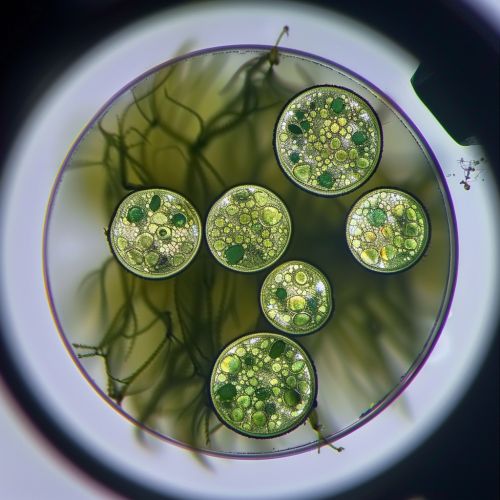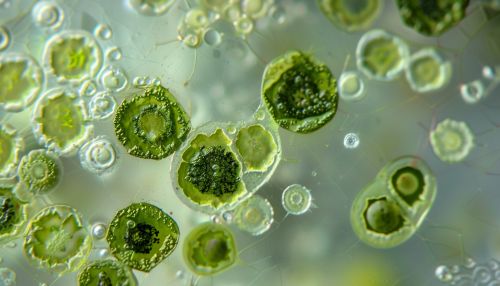Microbial Role in Climate Change Mitigation
Introduction
Microbial communities play a crucial role in the Earth's biogeochemical cycles and have significant potential in climate change mitigation. These microorganisms, including bacteria, fungi, archaea, and algae, contribute to carbon sequestration, greenhouse gas reduction, and the stabilization of ecosystems. This article delves into the various mechanisms through which microbes influence climate change mitigation, exploring their potential applications and the challenges associated with harnessing their capabilities.
Microbial Carbon Sequestration
Microbes contribute to carbon sequestration through several pathways, including photosynthesis, decomposition, and the formation of stable organic matter.
Photosynthetic Microorganisms
Photosynthetic microorganisms, such as cyanobacteria and microalgae, play a pivotal role in capturing atmospheric carbon dioxide (CO2) and converting it into organic carbon through the process of photosynthesis. These microorganisms are highly efficient at utilizing sunlight and CO2, making them valuable agents in carbon sequestration efforts.


Soil Microbes and Organic Matter Formation
Soil microbes, including bacteria and fungi, are essential in the decomposition of organic matter. They break down plant and animal residues, converting them into humus, a stable form of organic carbon that can persist in soils for centuries. The process of humification is critical for long-term carbon storage in terrestrial ecosystems.
Marine Microbial Carbon Pump
In marine environments, the microbial carbon pump plays a significant role in sequestering carbon. Marine microbes, including phytoplankton and heterotrophic bacteria, contribute to the biological carbon pump by transferring carbon from the surface ocean to the deep sea. This process involves the production of particulate organic carbon (POC) and dissolved organic carbon (DOC), which are transported to deeper waters, effectively removing CO2 from the atmosphere for extended periods.
Microbial Methane Oxidation
Methane (CH4) is a potent greenhouse gas with a global warming potential significantly higher than CO2. Certain microbes, known as methanotrophs, have the ability to oxidize methane, converting it into CO2 and water. This process, known as methanotrophy, occurs in various environments, including wetlands, rice paddies, and landfills.
Aerobic Methanotrophs
Aerobic methanotrophs are bacteria that utilize methane as their primary carbon and energy source in the presence of oxygen. These microbes are found in soils, sediments, and water columns, where they play a crucial role in mitigating methane emissions. The enzyme methane monooxygenase (MMO) is key to the oxidation process, catalyzing the conversion of methane to methanol.
Anaerobic Methanotrophs
Anaerobic methanotrophs, often associated with archaea, operate in oxygen-depleted environments such as marine sediments and anoxic zones of freshwater bodies. These microbes perform anaerobic oxidation of methane (AOM) in conjunction with sulfate-reducing bacteria, reducing methane emissions from these habitats.
Microbial Nitrogen Cycling
Microbes are integral to the nitrogen cycle, influencing the availability of nitrogen in ecosystems and the emission of nitrous oxide (N2O), another potent greenhouse gas.
Nitrification and Denitrification
Nitrifying bacteria convert ammonia (NH3) to nitrate (NO3-) through the process of nitrification. This process, however, can lead to the production of N2O as a byproduct. Conversely, denitrifying bacteria convert nitrate to nitrogen gas (N2) through denitrification, reducing N2O emissions. Optimizing these microbial processes can help mitigate N2O emissions from agricultural soils.
Biological Nitrogen Fixation
Certain bacteria and archaea can fix atmospheric nitrogen (N2) into bioavailable forms through biological nitrogen fixation. This process reduces the need for synthetic nitrogen fertilizers, which are associated with N2O emissions. Symbiotic relationships between nitrogen-fixing bacteria and plants, such as those found in legume root nodules, are particularly beneficial for sustainable agriculture.
Microbial Bioenergy Production
Microbes are harnessed for the production of bioenergy, offering a renewable alternative to fossil fuels.
Bioethanol and Biobutanol Production
Fermentative bacteria and yeasts are employed in the production of bioethanol and biobutanol from biomass. These biofuels can be used as alternatives to gasoline, reducing CO2 emissions from transportation. The optimization of microbial strains and fermentation processes is crucial for improving the efficiency and sustainability of biofuel production.
Biogas Production
Anaerobic digestion by microbial consortia produces biogas, a mixture of methane and CO2, from organic waste materials. Biogas can be used for heating, electricity generation, and as a vehicle fuel. The process also produces digestate, a nutrient-rich byproduct that can be used as a fertilizer, closing the nutrient loop in agricultural systems.
Challenges and Future Directions
While microbial processes offer significant potential for climate change mitigation, several challenges need to be addressed to fully harness their capabilities.
Environmental and Ecological Considerations
The introduction of microbial technologies into natural and managed ecosystems must be carefully managed to avoid unintended ecological impacts. Understanding the complex interactions between microbial communities and their environments is essential for developing sustainable solutions.
Technological and Economic Barriers
Scaling up microbial technologies for widespread application requires overcoming technological and economic barriers. Advances in biotechnology, such as genetic engineering and synthetic biology, hold promise for enhancing microbial efficiency and resilience. However, the cost-effectiveness and scalability of these technologies remain critical considerations.
Policy and Regulatory Frameworks
Effective policy and regulatory frameworks are necessary to support the development and deployment of microbial technologies for climate change mitigation. International cooperation and investment in research and development are essential for advancing these solutions.
Conclusion
Microbial communities play a vital role in climate change mitigation through carbon sequestration, methane oxidation, nitrogen cycling, and bioenergy production. While challenges remain, advances in microbial biotechnology and a deeper understanding of microbial ecology offer promising pathways for reducing greenhouse gas emissions and enhancing ecosystem resilience.
